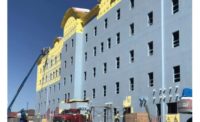Post-frame construction has been used in place of more conventional construction methods in just about every building type. Yet, when shown photos of post-frame buildings along with those built with traditional construction, most people have difficulty picking which were built using a frame building system.
Almost any type of low-rise construction, such as commercial, municipal, institutional and even residential, has been built with post frame. The primary reasons are that it costs less, gets built faster and is achieved without sacrificing structural integrity and visual aesthetics.
Prime for Many Sectors
Post-frame has been utilized to construct fire stations, car dealerships, schools, restaurants and more. Architects realize they have more flexibility in materials with post frame. If the structure needs expansive, flush walls with no columns sticking out into the workspace, post-frame is an excellent way to build. That would be just right for a building that needs to be quickly re-configured to display products or conduct activities.
Because designers can use numerous different materials, both inside and out, many different aesthetics are now being put in place using this innovative construction method.
When Time is a Concern
Budgets are controlling design today. Retail stores using post-frame building systems get up and running quicker with post-frame’s flexible design and speed of construction. A frame building system requires fewer trade workers for construction, which contributes to a faster build speed. A restaurant could be constructed in only five months, even under very tight site conditions. All of these factors further add to post-frame’s cost-effectiveness benefit when compared to other types of building systems.
A Lesson Learned
Many school districts had resorted to renovating aging buildings because the cost of new traditional construction was too much for the districts to bear. Experienced post-frame designers began work in earnest to educate school board members that new schools actually could be affordable. They gave presentations to these boards demonstrating the significant cost advantages possible by choosing post-frame.
Beyond a Simple Plaza
Modern post frame is recognized today as an ideal choice for commercial retail buildings. It is adaptable to virtually any architectural style. An excellent example is High Rock Landings, a distinctive shopping center in Lexington, NC. It was divided into six 20-by-60 inch retail units using post-frame technology.
The designer used creative touches including a deep fascia overhang, a stone wainscot, three gable style dormers with vinyl shakes, and a cedar-wrapped porch header with columns. To allow future tenants design flexibility, the owner left the units without concrete flooring until rented. That possibility is available only with post-frame construction.
Other Benefits
All the examples given show how post-frame construction is an effective choice for so many building types. Furthermore, there is no need for concern about issues of codes and “green” building certification.
Post-frame construction is code-accepted and code-compliant with all applicable building regulations. It meets standards set by the International Code Council, the American Wood Protection Association and the ASTM International.
To obtain LEED certification at any level, every advantage counts. Post-frame construction offers many sustainable qualities that make earning LEED rating points much easier. From reduced site disturbance during construction to creating a building envelope with room to accommodate IECC requirements, post-frame construction's many sustainable features make earning LEED rating points easier.
There are so many more application possibilities for post frame construction than could be presented in one article. Take some time to view these case studies of various types of structures presented by Post-frame Advantage.






Report Abusive Comment